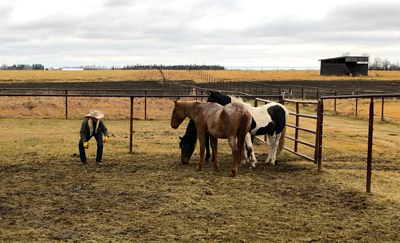I really thought I knew horses pretty well, but these mustangs are sure taking me back to school! Simply being around these boys is an education. They continually show me how aware I need to be of everything I do, because every alteration in me has meaning to them – whether I intend it to or not. I believe this is due not only their senses, which are so acute that they almost seem like super powers, but also because growing up in a wild herd has attuned them to tremendous subtleties of communication, something humans dull down in domestic horses.
This was brought home to me while I was working at getting closer to the mustangs. I would think things were going well, then suddenly, they would tense up. I assumed it was just my proximity – I’d get closer, they’d get nervous. Then I realized that proximity wasn’t the issue: it was my breathing! As I got closer, I would unintentionally hold my breath, which they picked up on immediately and associated with a potential threat. They weren’t necessarily seeing me as the threat, but the tension and irregularity within me was like sounding an alarm bell. They then looked at me as if to say, “What’s going on? Is there a danger nearby?”
This made me wonder: If holding my breath made them worry, would letting it out help them relax? I took a few deep, loud breaths, and threw in my best imitation of “licking and chewing” for good measure, as I know that horses often do that when a stressor is removed. Sure enough, the boys picked up on my “relaxation,” and their own tension greatly diminished.


